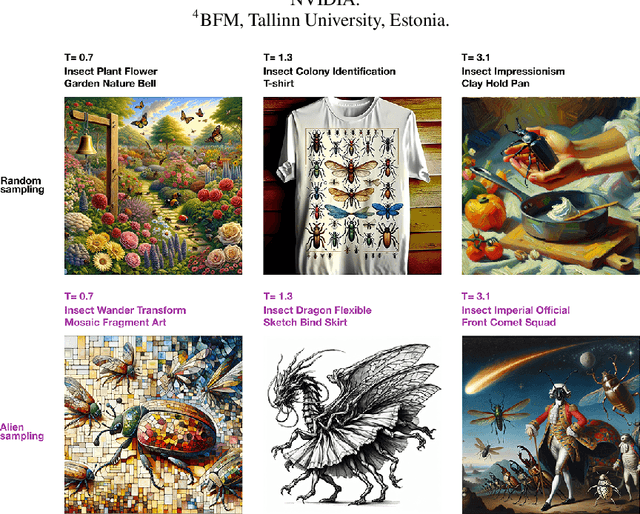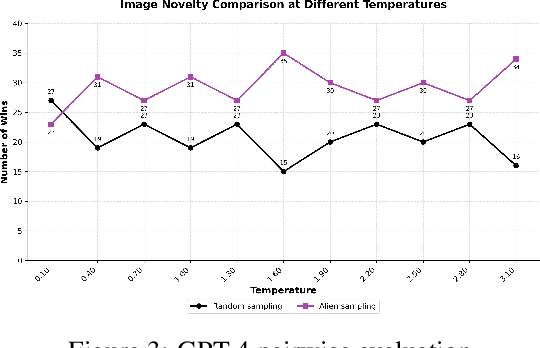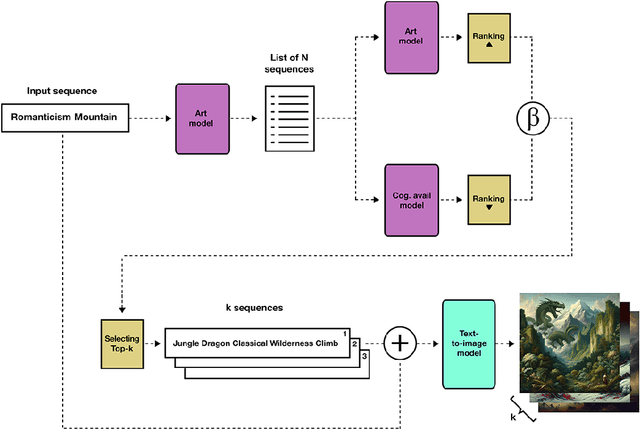Mar Canet Sola
Expertise elevates AI usage: experimental evidence comparing laypeople and professional artists
Jan 21, 2025



Abstract:Novel capacities of generative AI to analyze and generate cultural artifacts raise inevitable questions about the nature and value of artistic education and human expertise. Has AI already leveled the playing field between professional artists and laypeople, or do trained artistic expressive capacity, curation skills and experience instead enhance the ability to use these new tools? In this pre-registered study, we conduct experimental comparisons between 50 active artists and a demographically matched sample of laypeople. We designed two tasks to approximate artistic practice for testing their capabilities in both faithful and creative image creation: replicating a reference image, and moving as far away as possible from it. We developed a bespoke platform where participants used a modern text-to-image model to complete both tasks. We also collected and compared participants' sentiments towards AI. On average, artists produced more faithful and creative outputs than their lay counterparts, although only by a small margin. While AI may ease content creation, professional expertise is still valuable - even within the confined space of generative AI itself. Finally, we also explored how well an exemplary vision-capable large language model (GPT-4o) would complete the same tasks, if given the role of an image generation agent, and found it performed on par in copying but outperformed even artists in the creative task. The very best results were still produced by humans in both tasks. These outcomes highlight the importance of integrating artistic skills with AI training to prepare artists and other visual professionals for a technologically evolving landscape. We see a potential in collaborative synergy with generative AI, which could reshape creative industries and education in the arts.
Alien Recombination: Exploring Concept Blends Beyond Human Cognitive Availability in Visual Art
Nov 18, 2024



Abstract:While AI models have demonstrated remarkable capabilities in constrained domains like game strategy, their potential for genuine creativity in open-ended domains like art remains debated. We explore this question by examining how AI can transcend human cognitive limitations in visual art creation. Our research hypothesizes that visual art contains a vast unexplored space of conceptual combinations, constrained not by inherent incompatibility, but by cognitive limitations imposed by artists' cultural, temporal, geographical and social contexts. To test this hypothesis, we present the Alien Recombination method, a novel approach utilizing fine-tuned large language models to identify and generate concept combinations that lie beyond human cognitive availability. The system models and deliberately counteracts human availability bias, the tendency to rely on immediately accessible examples, to discover novel artistic combinations. This system not only produces combinations that have never been attempted before within our dataset but also identifies and generates combinations that are cognitively unavailable to all artists in the domain. Furthermore, we translate these combinations into visual representations, enabling the exploration of subjective perceptions of novelty. Our findings suggest that cognitive unavailability is a promising metric for optimizing artistic novelty, outperforming merely temperature scaling without additional evaluation criteria. This approach uses generative models to connect previously unconnected ideas, providing new insight into the potential of framing AI-driven creativity as a combinatorial problem.
Loading Ceramics: Visualising Possibilities of Robotics in Ceramics
Oct 04, 2024Abstract:This article introduces an artistic research project that utilises artist-in-residency and exhibition as methods for exploring the possibilities of robotic 3D printing and ceramics. The interdisciplinary project unites artists and architects to collaborate on a proposed curatorial concept and Do-It-With-Others (DIWO) technological development. Constraints include material, specifically local clay, production technique, namely 3D printing with a robotic arm, and kiln size, as well as an exhibition concept that is further elaborated in the next chapter. The pictorial presents four projects as case studies demonstrating how the creatives integrate these constraints into their processes. This integration leads to the subsequent refinement and customization of the robotic-ceramics interface, aligning with the practitioners' requirements through software development. The project's focus extends beyond artistic outcomes, aiming also to advance the pipeline of 3D robotic printing in clay, employing a digitally controlled material press that has been developed in-house, with its functionality refined through practice.
Visions of Destruction: Exploring a Potential of Generative AI in Interactive Art
Aug 26, 2024Abstract:This paper explores the potential of generative AI within interactive art, employing a practice-based research approach. It presents the interactive artwork "Visions of Destruction" as a detailed case study, highlighting its innovative use of generative AI to create a dynamic, audience-responsive experience. This artwork applies gaze-based interaction to dynamically alter digital landscapes, symbolizing the impact of human activities on the environment by generating contemporary collages created with AI, trained on data about human damage to nature, and guided by audience interaction. The transformation of pristine natural scenes into human-made and industrialized landscapes through viewer interaction serves as a stark reminder of environmental degradation. The paper thoroughly explores the technical challenges and artistic innovations involved in creating such an interactive art installation, emphasizing the potential of generative AI to revolutionize artistic expression, audience engagement, and especially the opportunities for the interactive art field. It offers insights into the conceptual framework behind the artwork, aiming to evoke a deeper understanding and reflection on the Anthropocene era and human-induced climate change. This study contributes significantly to the field of creative AI and interactive art, blending technology and environmental consciousness in a compelling, thought-provoking manner.
 Add to Chrome
Add to Chrome Add to Firefox
Add to Firefox Add to Edge
Add to Edge